Qasr Al Watan Abu Dhabi: Guide to UAE’s Presidential Palace
Qasr Al Watan, translating to “Palace of the Nation", is far more than an architectural marvel; it is a legal, political and cultural emblem of the United Arab Emirates (UAE). Located in the capital city of Abu Dhabi, the palace serves not only as a tourist attraction, but also as a venue showcasing the UAE’s constitutional framework and political heritage. This article provides an in-depth exploration of the palace, combining its touristic allure with its underlying legal and governmental essence.
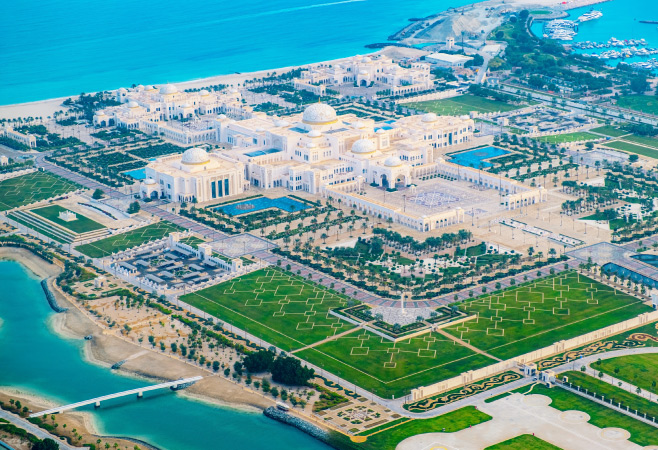
Aerial photo of Qasr Al Watan, Presidential palace
Architectural splendor and design
Exterior Grandeur
The palace’s exterior is made primarily of white granite, symbolizing purity and peace. The main dome measures 37 meters in diameter and rises 60 meters high, symbolizing unity and grandeur. The traditional Arabesque line is blended with the contemporary geometrical pattern and It reflects a continuous dialogue between tradition and modernity. The palace complex spans approximately 380,000 square meters, underlining its monumental scale and cultural significance.
Interior Detailing and Symbolism
The Dome Hall
The Great Hall beneath the dome features an elaborate chandelier composed of more than 350,000 crystals, symbolizing the brilliance of UAE’s legislative and cultural history
The Spirit of Collaboration Room
The Spirit of Collaboration Room has hosted high-level meetings and international delegations, though today it is mainly presented to visitors as a symbol of dialogue and cooperation.
The House of knowledge
This section includes rare manuscripts, historical records and legal treaties from across the Arab world, emphasizing the country’s scholarly contributions to civilizational development.
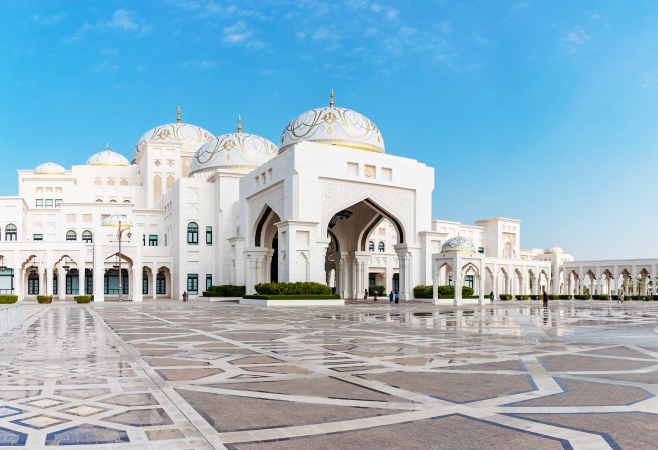
A picture of the Qasr Al Watan Main entrance
Cultural and educational impact
Library and scholarly access
The Qasr Al Watan Library is a cornerstone of national knowledge. It showcases over 50,000 books on history, culture, politics and knowledge, serving as a cultural landmark for visitors rather than a public research library.
Exhibitions and guided tours
Daily tours are provided in multiple languages, including English, offering legal and historical context to the architectural and cultural exhibits. These tours are designed to educate visitors about the UAE’s history, culture, governance traditions and national achievements.
Visitor experience and legal entry guidelines
Opening hours and admission fees
Qasr Al Watan is generally open daily from 11:00 AM to 6:30 PM, with last entry at 5:30 PM. On special occasions, hours may extend until 8:00 PM — visitors should check the official website for updated timings. Timings may vary on public holidays and during special events, so checking the official website before visiting is recommended.
Legal entry requirements for tourists
Visitors are required to adhere to the UAE visa policies, which vary according to nationalities. Visitors must follow UAE entry and security regulations, including presenting a valid passport or Emirates ID at the entrance.
Top things to See Inside Qasr Al Watan
When visiting Qasr Al Watan, tourists are welcomed into an architectural journey full of cultural richness and symbolic design. Key attractions include:
- The Great Hall (Dome Hall): The Great Hall is the main feature of the palace with a 37-meter wide dome and the largest chandelier in the UAE.
- The House of Knowledge: A room displaying rare manuscripts, religious texts and ancient scientific works of the Arab world.
- The Presidential Banquet Hall: A showcase of Emirati hospitality to state visitors, arranged with more than 149,000 pieces of silverware, crystal, and fine china to reflect the grandeur of official ceremonies.
- The Spirit of Collaboration Room: This room is where high level meetings are conducted and it demonstrates the diplomatic values of the UAE. In addition, the palace includes Al Barza, a majlis-style hall introduced in 2022, symbolizing Emirati traditions of consultation and dialogue.
- Palace in Motion Light Show: An awesome night show on the facade, telling the history of the UAE. The show typically takes place on Thursday, Friday and Saturday evenings - check the official website for updated schedules
All these areas provide another dimension of meaning and contribute to the knowledge of the visitor about the identity of the country.
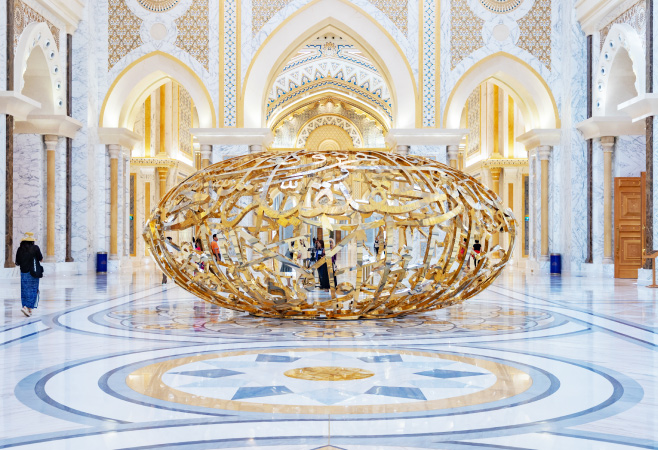
A picture of a golden sculpture at the East Hall of Qasr Al Watan
Best time to visit Qasr Al Watan
Qasr Al Watan is accessible all year round with the best period to visit the attraction being in the months of November to March when the weather conditions are cooler and support being outdoors and sightseeing. Do not arrive at noon (June-September months) as it might be very hot outside even though this is air-conditioned.
Evenings would be great for people who want to see the Palace in Motion show which usually takes place after sundown on specified days.
How to get to Qasr Al Watan
Qasr Al Watan lies on the Corniche West in Abu Dhabi and it is part of the Presidential Palace complex. The following is the way to get there:
- By taxi: Taxis are the most convenient and direct option. Just tell the driver “Qasr Al Watan". RTA-registered taxis are reliable and metered.
- By car: Visitors can park at the Visitor Center parking area and take a shuttle bus to the palace entrance.
- By public transport: Bus routes such as 94 and 032 can drop passengers near the Corniche area, but walking may be required.
- From Dubai: A 90-minute drive via E11 Highway connects Dubai to Qasr Al Watan. Guided tours from Dubai often include transportation.
Be sure to plan your route based on traffic and ticket timings.
Rules and etiquette when visiting
Qasr Al Watan is not only a tourist site but also a functioning government building. As such, all visitors must follow strict etiquette:
- Dress code: Visitors are required to wear modest clothing. Knees and shoulders ought to be covered. Avoid transparent or revealing clothes.
- Behavior: Noises, improper gestures or rowdy behavior is not allowed within the palace grounds.
- Restricted areas: Visitors are bound to remain in designated areas and not explore the staff-only areas or areas restricted by the government.
- Children: Children below 12 years are to be escorted with an adult.
Failure to comply could lead to being kicked out of the establishment, as per the UAE cultural tourism laws.
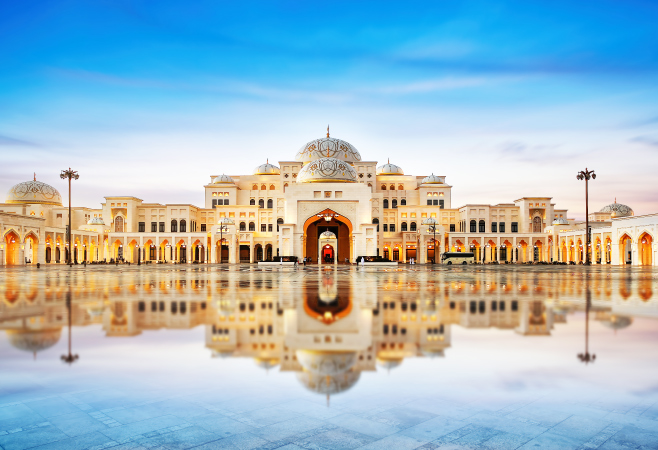
Presidential Palace, Qasr al-Watan with light laser show and reflection
Photography guidelines and tips
Most of the public places in Qasr Al Watan are permitted to photography, but it has legal and cultural limitations:
- Permitted areas: The majority of halls and exhibitions are photo-friendly, but flash photography can be prohibited in sensitive archival areas.
- No commercial Equipment: Tripods, drones and commercial arrangements need written permission in advance.
- Privacy: Do not take photos of the staff, security and other guests without their consent.
- Best shots: The most popular photos can be obtained with the exterior facade in the golden hour (in the morning or in the late afternoon) and never miss the Great Hall dome.
Photography is allowed in most areas, though professional equipment requires prior approval and visitors should respect privacy guidelines.
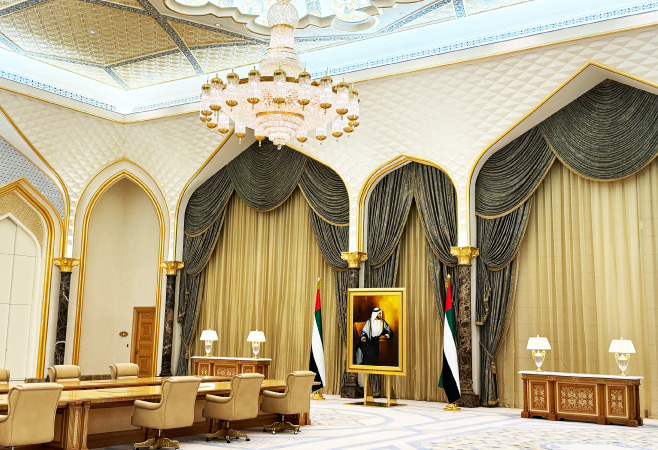
The Meeting Room at Qasr Al-Watan presidential palace of the United Arab Emirates, in Abu Dhabi, UAE
FAQs
- What makes Qasr Al Watan unique compared to other palaces in the UAE?
Qasr Al Watan is special since it is a museum of governance that is alive. It is not only government-oriented, but it also informs the citizens about the legal and constitutional path of the UAE.
- Is Qasr Al Watan open to tourists year-round?
Yes, Qasr Al Watan is open throughout the year, usually between 10 AM and 6 PM, even on public holidays, unless otherwise published.
- Are there any legal restrictions on photography within Qasr Al Watan?
Generally, photography is permitted, however flash photography and commercial equipment must be pre-approved, in adherence to the UAE laws regarding the protection of tourism and heritage.
- What documents are required to enter Qasr Al Watan as a foreign tourist?
One requires a valid passport, visa (where applicable) and in some cases government-issued identification. Security checks are compulsory.
- Does the palace provide legal and historical context during guided tours?
Yes, guided tours are provided with explanations of the legal system in the UAE, constitutional development and form of governance, so the process is also interesting and informative.
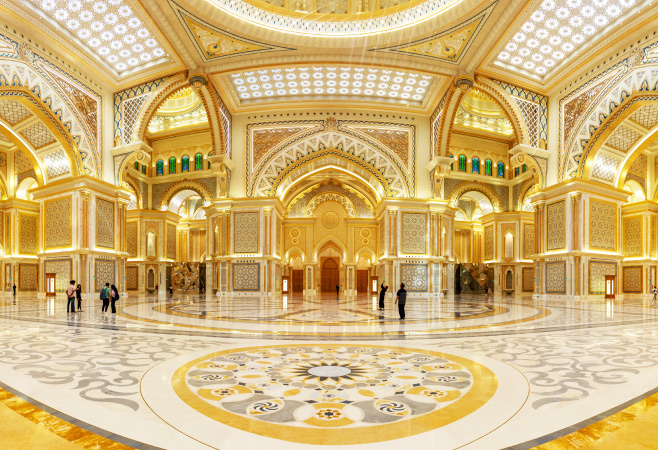
A picture of the lavish Great Hall of the Qasr Al Watan presidential palace
Conclusion
Qasr Al Watan is not a touristic destination - it is a living symbol of governance, legislation and patriotism. It is the embodiment of openness, knowledge and the force of tradition. Every corner, dome and exhibit speaks about the cultural and constitutional superiority of the UAE. Whether you are a legal scholar, a culture lover or a tourist who is simply inquisitive, Qasr Al Watan is a place that will teach you, inspire you and astonish you.
Related Articles
- Al Montazah Parks Sharjah: Top water & theme park for tourists
- The National Aquarium in Abu Dhabi: Top tourist guide
- Yas Waterworld Abu Dhabi: Ultimate travel guide for tourists
- Qasr Al Watan Abu Dhabi: Guide to UAE’s Presidential Palace
- Emirates Palace Mandarin Oriental Abu Dhabi: Travel guide
- Atlantis The Palm: A luxurious resort experience in Dubai
- Dubai Opera: The crown jewel of performing arts in Middle East
- Ferrari World Abu Dhabi: The complete guide for culture lovers
- Warner Bros. World Abu Dhabi: An entertainment wonderland
- IMG Worlds of Adventure: Tourist guide to Dubai’s indoor marvel

